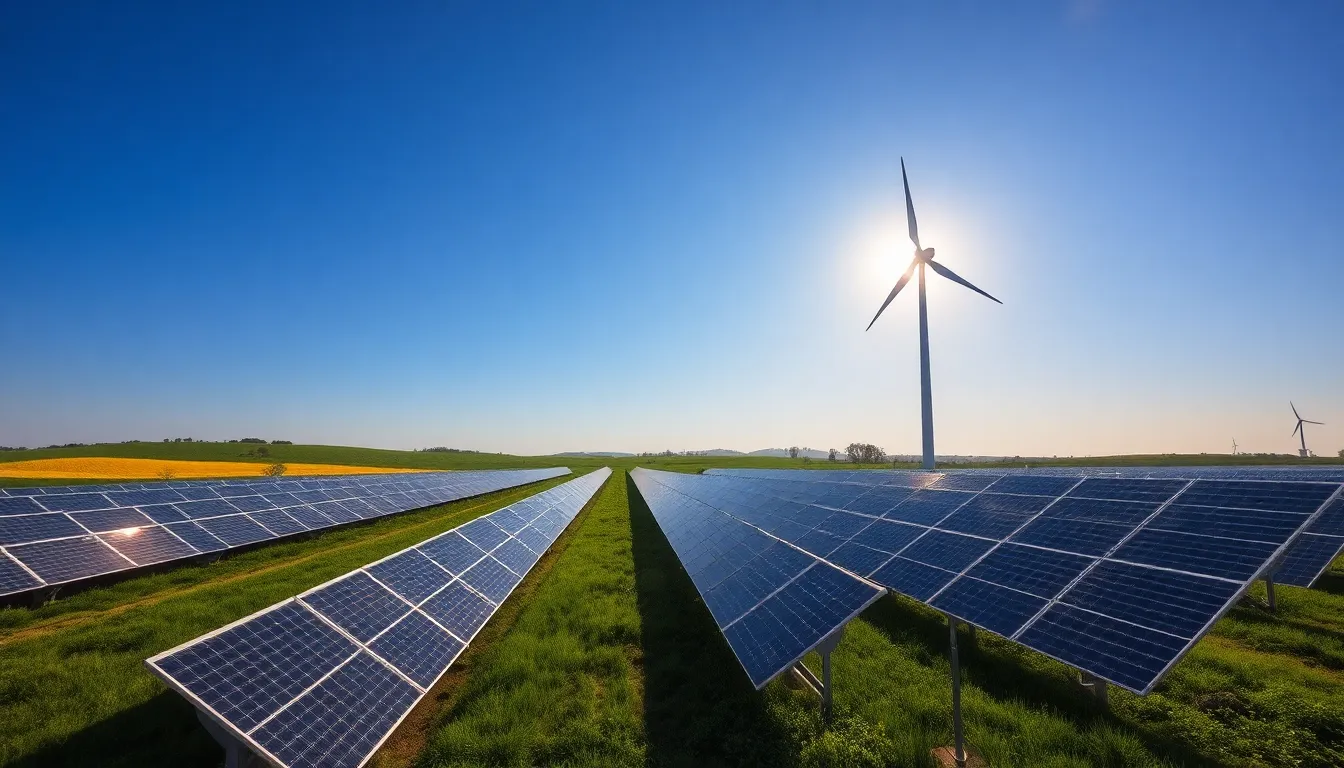Table of Contents
ToggleIn a world where the sun shines brighter than your neighbor’s new car and the wind blows harder than your last family gathering, renewable energy sources are stepping into the spotlight. These eco-friendly powerhouses not only help save the planet but also keep our wallets happy. Who wouldn’t want to ditch the fossil fuels and embrace energy that’s as fresh as a morning breeze?
Overview of Renewable Energy Sources
Renewable energy sources encompass a variety of naturally replenished resources, including solar, wind, hydro, geothermal, and biomass. Solar energy captures sunlight using photovoltaic cells, converting it into electricity. Wind energy relies on turbines that harness the power of moving air to generate electrical energy.
Hydropower represents one of the oldest forms of renewable energy, utilizing flowing water from rivers or dams to produce electricity. Geothermal energy taps into the Earth’s internal heat, providing a reliable power source with minimal environmental impact. Biomass energy utilizes organic materials, such as plant matter and waste, to produce heat or electricity through combustion.
Transitioning to renewable energy sources significantly reduces greenhouse gas emissions. For example, a study from the International Energy Agency (IEA) indicates that a shift to renewables could reduce global CO2 emissions by up to 70% by 2050. Furthermore, purchasing renewable energy can yield financial benefits, as prices for technologies like solar panels have decreased by over 85% in the last decade.
Countries worldwide are investing in renewables, with an estimated global capacity of 2,800 gigawatts of wind and 1,200 gigawatts of solar energy by 2021. Renewable energy not only supports energy independence but also creates numerous jobs in innovative sectors. The transition from fossil fuels fosters sustainable economic growth, making it an attractive focus for policymakers and business leaders alike.
These energy sources present numerous advantages, not just environmentally, but also economically, promoting long-term sustainability.
Types of Renewable Energy Sources

Numerous renewable energy sources exist, each offering unique benefits and capabilities. Here’s a closer look at some of the main types.
Solar Energy
Solar energy converts sunlight into electricity using solar panels. This method harnesses photons from sunlight to create direct current (DC) power. Solar installations can be found on rooftops or in large fields called solar farms. The global solar market experienced massive growth, with installed capacity reaching over 1,000 gigawatts (GW) in 2023. Technological advancements led to a significant decrease in costs, making solar energy more accessible for homeowners and businesses alike.
Wind Energy
Wind energy generates power through wind turbines that convert kinetic energy into electricity. Turbines capture wind movement, spinning blades to create mechanical power, which is converted to electricity. Offshore wind farms have emerged as a vital part of this sector, with some projects producing over 10 GW collectively. Continued innovations in turbine efficiency have increased output, reducing costs per megawatt-hour significantly.
Hydropower
Hydropower utilizes flowing water to generate electricity through dams or run-of-the-river systems. This method creates energy by capturing the energy of falling or flowing water. Globally, hydropower represents one of the largest renewable energy sources, providing approximately 15% of the world’s electricity. It’s also a stable and reliable energy source, with the ability to adjust output rapidly based on demand.
Biomass
Biomass energy derives from organic materials, including plant and animal waste. This energy source can be converted into biofuels or directly burned to produce heat and electricity. Biomass contributes to waste reduction while providing a local energy solution. Major forms include wood pellets and agricultural residues, which help lower greenhouse gas emissions by using existing waste products.
Geothermal Energy
Geothermal energy taps into the Earth’s internal heat to produce electricity and heating. This method relies on steam or hot water from beneath the Earth’s surface. Geothermal power plants operate efficiently and have low environmental impact. Currently, the installed geothermal capacity exceeds 15 GW worldwide. Utilizing geothermal resources provides a continuous energy supply, contributing to energy independence and stability.
Benefits of Renewable Energy Sources
Renewable energy sources provide multiple advantages that contribute to environmental well-being and economic development.
Environmental Impact
Renewables significantly lower greenhouse gas emissions. By transitioning to these energy sources, it’s possible to reduce global CO2 emissions by up to 70% by 2050. Cleaner air results from decreased reliance on fossil fuels, leading to improved public health. Species preservation benefits from reduced habitat disruption caused by conventional energy extraction. Moreover, the sustainable nature of renewables minimizes resource depletion, ensuring availability for future generations.
Economic Advantages
Cost savings form a major incentive for switching to renewable energy. The price of solar panels has dropped dramatically by over 80% since 2010, making solar energy accessible. Wind energy also became more affordable, with levelized costs falling significantly in recent years. Investments in renewables promote job creation in innovative sectors, strengthening local economies. Furthermore, using renewable resources encourages energy independence, insuring against volatile fossil fuel markets.
Energy Security
Energy security becomes stronger with the adoption of renewable sources. Diverse energy generation reduces reliance on imported fuels, enhancing self-sufficiency. Local production limits vulnerability to geopolitical tensions and supply chain disruptions. Increased investment in renewables creates a stable energy infrastructure that fosters resilience. In addition, harnessing renewables promotes energy diversification, protecting against price fluctuations in the fossil fuel market.
Challenges Facing Renewable Energy Sources
Renewable energy sources provide significant benefits, but they also face distinct challenges. Addressing these obstacles is essential to optimize the transition to sustainable energy.
Intermittency Issues
Intermittency poses a major challenge for renewable energy sources. Solar and wind energy depend on weather conditions, which can lead to inconsistent power generation. Energy storage systems, such as batteries, help mitigate these fluctuations by storing excess power for later use. Despite advancements, current storage technology struggles to provide sufficient capacity for high-demand periods. Additionally, integrating intermittent sources into existing grids complicates energy management, requiring innovative solutions to ensure a reliable supply.
Infrastructure Requirements
Infrastructure demands for renewable energy sources present another hurdle. Upgrading or expanding transmission networks is necessary to connect renewable generation sites to consumers. Many regions lack the adequate infrastructure to support widespread renewable adoption, resulting in limitations on energy distribution. The construction of new facilities involves substantial financial investments, time commitments, and regulatory approvals. Local governments and utilities must collaborate to overcome these obstacles, ensuring systems can effectively deliver renewable energy to meet growing demands.
Future of Renewable Energy Sources
The future of renewable energy sources looks promising, driven by continuous advancements and supportive policies. Technological innovations play a critical role in enhancing efficiency and accessibility.
Technological Innovations
Innovations in renewable energy technology lead to significant improvements in energy generation. Solar panel efficiency has increased dramatically, with some panels converting over 22% of sunlight into electricity. Wind turbines are now taller and capable of harnessing wind at greater heights, unlocking more consistent energy generation. Energy storage solutions, such as lithium-ion batteries, have seen advancements that enhance their capacity and lifespan, making them more suitable for large-scale applications. Smart grids enable better energy management, allowing for real-time data on energy consumption and distribution. Collectively, these innovations facilitate the shift towards more effective and sustainable energy systems.
Policy Frameworks
Strong policy frameworks play a vital role in shaping the renewable energy landscape. Countries that implement incentives, such as tax credits and feed-in tariffs, encourage investments in renewable technologies. Renewable Portfolio Standards (RPS) mandate utilities to source a specific percentage of their energy from renewables, driving demand and investment. International agreements, like the Paris Accord, push nations to commit to lower greenhouse gas emissions, promoting renewable energy adoption. Local governments also contribute by supporting community solar initiatives and renewable energy projects. Coordinated policies at various levels foster a conducive environment for the growth of renewables, ensuring a sustainable energy future.
The shift toward renewable energy sources is not just a trend; it’s a necessity for a sustainable future. Embracing these cleaner alternatives can lead to significant environmental benefits and economic growth. As technology advances and costs continue to decline, the transition becomes increasingly feasible for individuals and businesses alike.
Investments in renewables are creating jobs and fostering energy independence while reducing greenhouse gas emissions. Despite challenges like intermittency and infrastructure needs, ongoing innovations and supportive policies are paving the way for a more resilient energy landscape. The commitment to renewable energy isn’t merely about energy production; it’s about ensuring a healthier planet and a more sustainable economy for generations to come.



